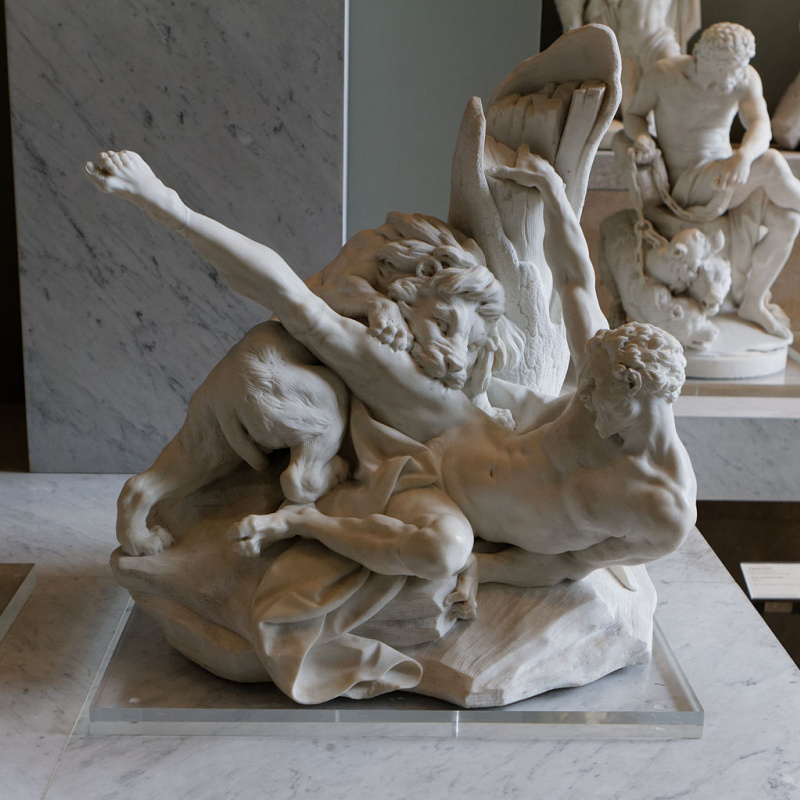Milo of Croton
Description of the artwork «Milo of Croton»
Milo of Croton was a legendary Greek athlete from the Italian city of Croton. He lived in the 7th century BC and is mentioned in the works by Herodotus, Pindar, Plutarch, Ovid. He possessed such outstanding physical abilities that he was said to only be second to Hercules. Croton won six times at the Olympic Games (in wrestling competitions), seven times at the Pythian Games, nine times at the Nemean Games, and ten times at the Isthymian Games.
Milo of Croton impressed not only the writers of antiquity. He was also the idol of Porthos in The Three Musketeers by Alexandre Dumas:
“I have heard,” said Porthos, “of a certain Milo of Crotona, who performed wonderful feats, such as binding his forehead with a cord and bursting it — of killing an ox with a blow of his fist and carrying it home on his shoulders, et cetera. I used to learn all these feat by heart yonder, down at Pierrefonds, and I have done all that he did except breaking a cord by the corrugation of my temples.”
French sculptor Étienne Maurice Falconet was 28 years old when he decided to enter the Academy of Arts. As an introductory work, Falconet made a plaster sculptural group, which depicted a near-death episode from the life of Milo of Croton. When the hero was already far from young, but still very ambitious, he decided to break a stump with his hands, which the axes of a dozen woodcutters had not been able to cope with before. Milo was unlucky twice: his hand was pinched between pieces of wood and at that moment a lion attacked the hero who had no opportunity to escape or fight.
“The attacking beast knocked him to the ground,” the art historian Zinaida Zaretskaya describes the work by Falconet, “Milo crushed his free hand with the whole weight of his body, the other remained pinched. He could not get up, his head threw back, the veins on his neck swelled, an expression of unbearable anguish appeared on his face. It seems that screams of pain, horror, impotent rage are escaping from his open mouth. Sharp contrasts of light and shadow create a feeling of extreme tension of the body, emphasize the last efforts of a mighty man dying in the struggle.”
The Académie Française accepted the emotional and very realistic sculpture rather coldly. Falconet was accused of excessive naturalism and that he allegedly stole the idea from the “French Michelangelo” Pierre Puget (the 17th century sculptor also had his own Milo of Croton). Falconet only became an academician 10 years later, when he repeated the sculpture of Milo of Croton, but this time not in plaster, but in marble. The gypsum Milo is now kept in the State Hermitage, and its marble counterpart is in the Louvre.
The question arises: why did the sculptor return to this subject, which the public and critics underestimated for the first time, and did not come up with something else to get the title of academician? There is every reason to believe that Falconet, who was well acquainted with ancient philosophy and literature, put an autobiographical meaning in the story about Milo of Croton. The hero entering an unequal battle is himself, who was born into a poor family, in which tillers prevailed at one side and shoemakers at the other. His situational enemies, the stump and the lion, are the difficulties he had to face while paving his way in art. And, unlike Milo of Croton, in his final fight, the sculptor Falconet, albeit not immediately, managed to achieve something. For the marble Milo, he received the title of academician, which meant his right to a free workshop in the Louvre, extraordinary royal commissions and even a noble title. It was really not bad for a son of a Parisian carpenter.
By the way, if you want to know what Étienne Maurice Falconet looked like, take a look at his sculpture. The architect provided Milo of Croton with his own facial features. He informed his historian friend Leveque that “the head is folksy, because I made it from mine”.
Anna Vcherashniaya


